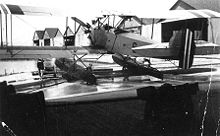- Marinens Flyvebaatfabrikk M.F.8
-
MF.8 Role Training seaplane National origin Norway Manufacturer Marinens Flyvebaatfabrikk Designer Johann E. Høver First flight 30 May 1924 Primary user Royal Norwegian Navy Air Service Number built 8 The Marinens Flyvebaatfabrikk MF.8 (also known as the Høver MF.8, after its designer) was a military training seaplane built in Norway in the 1920s.[1][2]
Contents
Design and development
It was a conventional two-bay biplane design based on the M.F.6 and M.F.7, with open cockpits in tandem for the student and instructor.[3] The main difference between the M.F.8 and the M.F.7 were that M.F.8 had a new tail rudder and wing profile, in order to increase landing speed. The new profile had been developed by the Swedish professor Nordensvan, in cooperation with the Norwegian Army Air Service.[4]
Engine problems
The first building of the two first aircraft began in December 1923, F.6 (III) being finished 30 May 1924 and F.12 in August the same year. The first aircraft were delivered with 100 hp Scania Vabis engines, which proved too weak and was replaced with 160 hp Beardmore or Sunbeam engines. For the next two aircraft produced the Royal Norwegian Navy Air Service (RNNAS) settled on a 160 hp Mercedes engine and aircraft with this engine model were designated as M.F.8Bs. However, in 1932 Marinens Flyvebaatfabrikk had to find a replacement for the Mercedes engines as spare parts for it became hard to procure. A Bristol Lucifer was borrowed from Kjeller Aircraft Factory and a Walter Regulus from a factory in Prague,[4] both being tested at Horten. Still, both engines proved to costly to finance with the available budgets. Fortunately for the type hardly used Armstrong Siddeley Cheetah IIA engines were found in British surplus stockpiles and purchased for a mere 500 Norwegian kroner apiece. After rebuilding with a larger propeller the yield of the engine was reduced from 265 hp to 180 hp, perfect for trainer aircraft, and was used to equip both the M.F.8 and M.F.10 trainers. By early summer 1936 all M.F.8s had been rebuilt with Armstrong Siddeley Cheetah IIA. However, once again it proved a mistake to invest in an engine that was no longer in production and spare parts once more became a major problem. The Walter Regulus engine had performed well during the testing in Horten and funds were found to finance its acquisition, only for the Norwegians to discover that the engine did not perform as well as anticipated and in 1938 the Czech factory ceased producing it. Replacing the Walter Regulus was the American Jacobs L-4M engine, installed in the aircraft during the winter of 1939/1940.[5]
Operational use
In all the M.F.8 design was very successful, with the pilots of the RNNAS receiving their first training on it up until the German invasion of Norway, the last of the type having been delivered in October 1935. Plans to replace it with a version of the Army's Tiger Moth trainer equipped with floats failed when tests in 1934 showed that the Tiger Moth was of little value as a seaplane. Marinens Flyvebaatfabrikk began designing and prototype production on the monoplane trainer Marinens Flyvebaatfabrikk M.F.12 from 15 June 1937, intended as a replacement for the M.F.8, but internal disagreements delayed the introduction of the new type until the German invasion halted all work.[5] Five of the eight M.F.8s produced were still in service at the outbreak of the Second World War, flying for the last times on 13 and 14 December 1939 before being placed in storage at Karljohansvern where they were all captured by the Germans on 9 April 1940.[6]
Specifications
Data from Hafsten 2003, p.225
General characteristics
- Crew: Two, pilot and instructor
- Length: 9.70 m (31 ft 10 in)
- Wingspan: 14.50 m (47 ft 7 in)
- Height: 3.50 m (11 ft 6 in)
- Empty weight: 975 kg (2,150 lb)
- Gross weight: 1,275 kg (2,810 lb)
- Powerplant: 1 × Armstrong Siddeley Cheetah IIA, 210 kW (280 hp)
Performance
- Maximum speed: 105 km/h (65 mph)
- Cruising speed: 80 km/h (50 mph)
- Range: 370 km (230 miles)
Notes
- ^ Taylor 1989, 620
- ^ The Illustrated Encyclopedia of Aircraft, 2414
- ^ Frebergsvik, Lars. "Flyfabrikken fra sped start i 1912 til nedleggelse i 1965" (in Norwegian). Borreminne. Borre Historielag. http://borreminne.hive.no/aargangene/1993/03-flyfabrikk.htm. Retrieved 2008-10-23.
- ^ a b Hafsten 2003: 101
- ^ a b Hafsten 2003: 102
- ^ Hafsten 2003, 225–226
References
- Hafsten, Bjørn; Tom Arheim (2003) (in Norwegian). Marinens Flygevåpen 1912–1944. Oslo: TankeStreken AS. pp. 45, 49, 101–102, 225–226. ISBN 82-993535-1-3.
- The Illustrated Encyclopedia of Aircraft. London: Aerospace Publishing.
- "MF.8 Høverjager". Уголок неба. http://www.airwar.ru/enc/other2/mf8.html. Retrieved 2008-10-23.
- Stein, Gulli. "Skoleflyet MF-12" (in Norwegian). Borreminne. Borre Historielag. http://borreminne.hive.no/aargangene/1998_99/08-skoleflyet.htm. Retrieved 2008-10-23.
- Taylor, Michael J. H. (1989). Jane's Encyclopedia of Aviation. London: Studio Editions.
Aircraft produced by Marinens Flyvebaatfabrikk Lists relating to aviation General Aircraft (manufacturers) · Aircraft engines (manufacturers) · Airlines (defunct) · Airports · Civil authorities · Museums · Registration prefixes · Rotorcraft (manufacturers) · TimelineMilitary Accidents/incidents Records Categories:- Norwegian military trainer aircraft 1920–1929
- Seaplanes and flying boats
- Marinens Flyvebaatfabrikk aircraft
Wikimedia Foundation. 2010.


